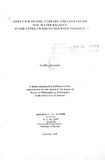| dc.description.abstract | The influence of soil, climate, and land use on soil water balance was investigated in 3
agroclimatic zones within the Upper Ewaso Ng'iro Basin. Water balance was quantified
for various land uses and management systems in each zone. These were natural forest (NF),
grazing land (GL) and potato cropland (PC) on a mollic Andosol at Karuri; conventional
tillage (CT), mulch tillage (MT), overgrazing (OG) and controlled grazing (CG) on a ferric
Luvisol at Kalalu; and perennial grass (PO), enclosed perennial grass (PE), bare ground
(BO), enclosed bare ground (BE) and runon (bare ground with a bush and grass at the lower
end (RO) sites on a chromic Lixisol at Mukogodo. Soil moisture, runoff and soil cover for
each system; and rainfall and evaporation at each site, were monitored for four rainy
seasons (September 1993-August 1995). Selected soil physical properties for each system
were also measured.
The climatic water balance was negative at all sites as the ratio of mean annual rainfall to
mean annual potential evaporation was 0.65, 0.47 and 0.16 for Karuri, Kalalu and
Mukogodo, respectively. The annual rainfall means during the monitoring period were
similar to available long term records. Total mean runoff as percentage of rainfall in the
four seasons at Karuri was 6.6% in PC and 1.6% in GL; at Kalalu it was 6.6, 0.01, 30.0
and 4.0% in CT, MT, OG and CG, respectively; and at Mukogodo it was 25.1, 35.2, 9.9,
51.1 and 47.6% in RO, PO, PE, BO and BE, respectively. Runoff from cropland at Karuri
and Kalalu during big storms (>20 mm day") was up to 40% of rainfall, and for similar
events up to 80% from overgrazed sites at Kalalu and Mukogodo. Bush canopy basal
cover (RO) intercepted and infiltrated up to 50% of runoff flowing from bare ground.
Both BO and BE at Mukogodo had similar cover. However, cover in PE increased to
about 3 times that in PO. Runoff decreased with increase of cover in all sites and
treatments. Calculated minimum (threshold) amount of rainfall required to generate
runoff increased with soil cover and ranged from 11-14 mm day" in cropland and from 6-
12 mm day" in grazing land. Runoff significantly correlated with amount of rainfall in
cropland only at Karuri and for cover >30% (r2 = 0.71), but at all sites in grazing land (r2
= 0.65 at Karuri, 0.76-0.94 at Kalalu, and 0.51-0.62 at Mukogodo). Runoff also
significantly correlated with rainfall erosivity at all sites; that in grazing land (r2 = 0.88 at
Karuri, 0.56-0.98 at Kalalu, and 0.49-0.68 at Mukogodo) was stronger than in cropland
(r2 = 0.49-0.79 at Karuri and 0.77 at Kalalu).
Available soil water stored at Karuri ranged from 140, 130 and 120 mm in the driest
period to 230, 205 and 185 mm in the wettest period of the year for NF, GL and PC,
respectively, in 160 em soil depth. On annual average, NF (192 mm) had significantly
higher available water than GL (169 mm) and PC (153 mm). Available water stored in
Kalalu cropland was 88 and 37 mm in the driest period, and 222 and 176 mm in the
wettest period of the year for MT and CT, respectively in 160 em soil depth. Higher
moisture was recorded in MT than CT in both times. In grazing land, CG stored 46%
more water (147 mm) than OG (101 mm) in the wettest period, but there was no available
water in the driest period in both CG and OG. Moisture recharge in the wet seasons was
limited to only 90 em in OG, but like in cropland, it percolated beyond 120 ern in CG.
None of the treatments at Mukogodo had any available water in the dry seasons. Even in
the wettest period, only 19, 13, 20, 9 and 7 mm of water was available within a depth of
80 em in RO, PO, PE, BO and BE, respectively. That in RO and PE were significantly
higher (P<0.05) than the rest. Moisture percolated to only about 50 em under good cover
and to about 30 cm on bare ground even in the wettest period at Mukogodo.
Water use was higher in PC (4-18%) and GL (7-20%) than NF in the 4 growing seasons,
indicating that the forest extracted less water than potato and grass from within the 160
em soil depth. At Kalalu, MT used more (18-42%) water than CT during the long rains.
However, in the short rains, some moisture was conserved and carried over, resulting in
lower (10-26%) water use in MT compared to CT. Water use was higher (21-24%) in CG
compared to OG in all seasons. At Mukogodo water use was 13-20% and 32-55% lower
in PO and BO, respectively, than RO in the 4 growing seasons. In all seasons PE used
significantly (P<0.05) more water than PO (23-61%) and BO (57-95%). Higher (8-33%)
water use by PE than RO was attributed to higher evapotranspiration by grass in the open
compared to that under bush canopy. This water balance study indicated that apart from
soils and climate, differences in land use and surface soil management also influenced
soil water storage and subsequent use within the basin. | en |

